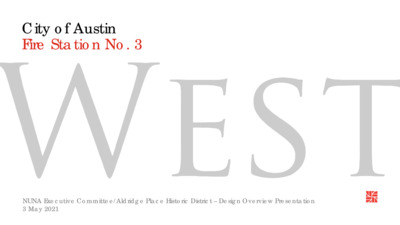D.4.4 - 201 W 30th St - Presentation to neighborhood — original pdf
Backup

City of Austin Fire Station No. 3 NUNA Executive Committee/Aldridge Place Historic District – Design Overview Presentation 3 May 2021 Context Location: 201 West 30th St Currently, all fire trucks are being parked outside the apparatus bay. Recent changes to the floodplain maps cause a significant portion of the building to be in the floodplain. Introduction Overview Construction completed on February 21, 1957 Architect: Roy Thomas Does not have any Landmark designations at present Adjacent to the Aldridge Place Historic District Building History Repairable Not Repairable Overview The building has suffered two types of structural damage: 1) General wear and tear based on age. (entire structure) 2) Overstressing of the foundation due to parking trucks that are heavier than the original design load. (apparatus bay only) Structural Damage Shore up and preserve Demolish and replace Overview For the areas that have just suffered age- related wear and tear, the intent is to shore up that portion of the structure and preserve it. For the apparatus bay, the intent is to demolish the portion of the building that is beyond repair and replace it with a new structure that is sensitive but of its time. Project Intent Structural The City of Austin has conducted three studies of the building. Two structural studies and one geotechnical report. The second structural study specifically addressed potential remediation of the existing structure. All reports have been independently reviewed by the current structural engineer, who concurs with the studies’ methodologies and conclusions. Studies Historic An historic survey of the area was conducted. This building was identified in the survey. Recommendations for landmark were included. Reasoning: Possesses integrity and significance in Postwar Infrastructure Expansion. Survey Objectives 1) Save the historic fabric that can be saved and put it in good structural standing for the future. 2) Preserve the original historic use/function of the building. 3) Provide the Fire Department and EMS with the modern facility they need to operate effectively and efficiently for decades to come thus providing vital life-safety services to the area. 4) Get the fire trucks parked indoors for protection of the equipment, speed of response times, and aesthetic improvement of the neighborhood. 5) Create an addition that is respectful of the original, but not a false recreation of mindless mimicry. Project Goals What we asking for from the neighborhood 1) Input to help the design team fully understand the concerns of all stakeholders. 2) The ability to say to the Landmark Commission that we have engaged in dialogue with the neighborhood. 3) If there is support for the project, to have the neighborhood and/or historic district communicate that support to the Landmark Commission in an official manner. 4) If there is not support for the project, to learn what barriers exist to gaining that support. 5) To engage in a good-faith effort of mutual dialogue such that stakeholders are not surprised by the project and genuinely feel a part of the process. Neighborhood Engagement Proposal With the designation of the new 100-year floodplain, the remaining buildable area is extremely limited. (Shown in red) This means the only available land for a new apparatus bay is the land where the existing damaged one stands. Expansion is limited to the red area to the right of the current bay. Site Plan Existing Proposal Apparatus bay is expanded into the building area to the right of the plan. Parking in front is reconfigured to meet ADA. Site lighting is added for safety, convenience, and function. Site Plan Proposed Proposal Importance of roof line Use of brick, but in an obviously different blend to distinguish old from new Reuse of original signage Compatible massing Use of period-appropriate detailing Addition of “UT Burnt Orange” elements to tie into area pride Design Highlights Proposal Faster operating bay doors to improve response times. Addition of spaces to provide for operational requirements. Significantly stronger structure accommodating the weight of both current and future vehicles. Slightly higher apparatus bay allowing for the height of new vehicles and the maintenance clearances they require. Improved site lighting and ADA compliance. Functional Improvements Questions and Discussion WestEast Design Group, LLC Architectural, Interior Design, Planning Mechanical, Electrical + Plumbing 210.530.0755 | westeastdesign.com